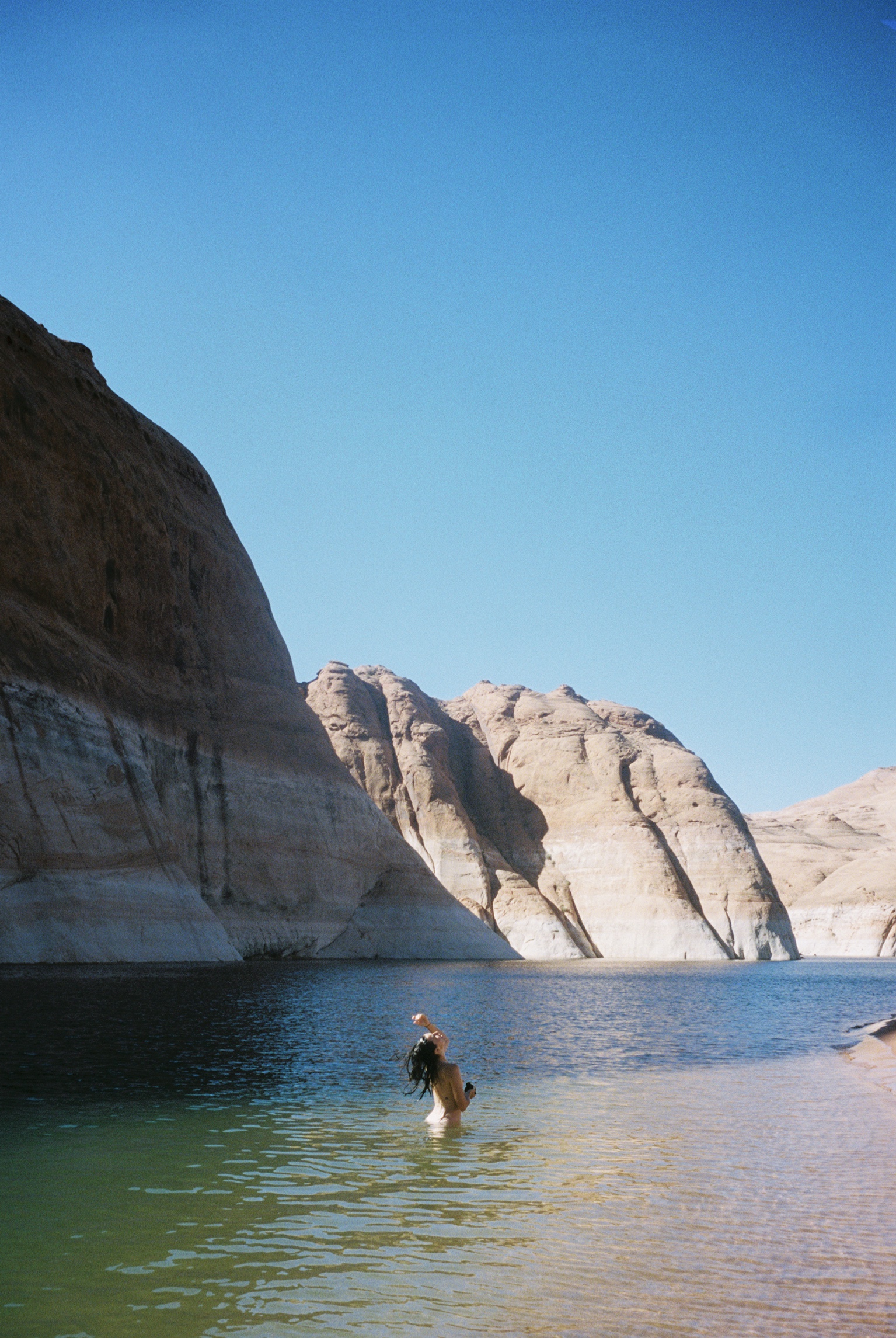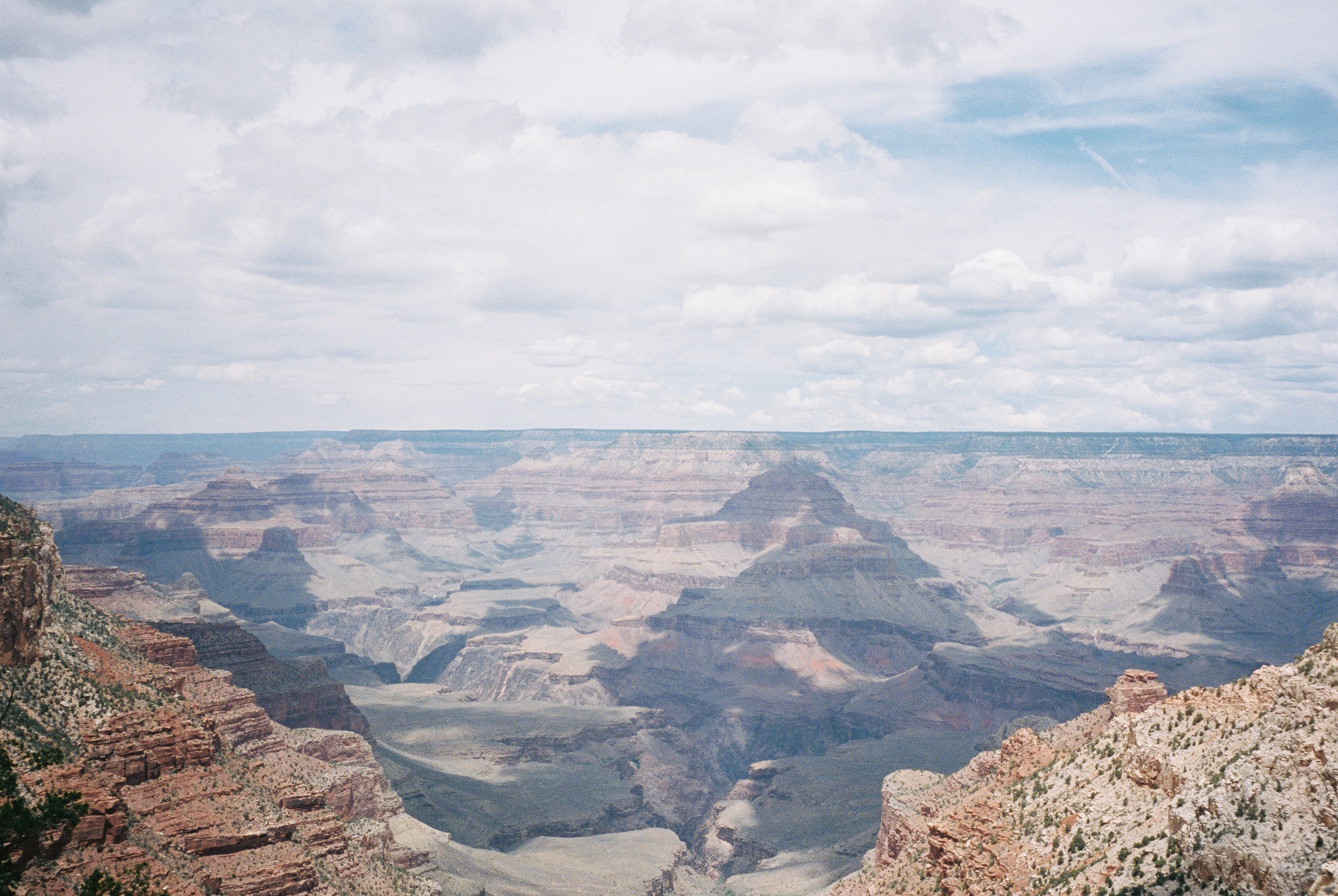Human Thought is a Geological Force
Stay Wild
Seeking Water in the Colorado River Basin
Story by Joal Stein // @Joal______
Photos by Sarah Lewis // @sarleww
LAKE POWELL
I turn to my traveling companions, Sara and Sarah, and mouth, “Wow.” We have just driven over the Glen Canyon Dam and are crossing from Page, Arizona into Utah towards Lone Rock Campground. The line of RVs and campers lined at the shore resembles a combination of the movie Twister and Burning Man: storm-chasers and extreme campers as gray clouds roil overhead and dust pelts our faces. There’s no way we’ll make it through the night in our tents.
The next day we rent a pontoon boat to explore the bays and canyons in this sprawling reservoir. As the employee gives us the mandatory instructions on how to operate the boat, I am barely paying attention because I’m trying to imagine a once barren brown-and-red desert landscape—a time before the construction of the dam in 1963 backed up the Colorado River and flooded this region. Gliding into the bay and along the wind-swept canyon walls, my eyes catch the transmission lines studded along the ridges, evidence that this is not just a recreational area for the adventure-minded, but a site of power generation. Another link along the Colorado River Basin that powers much of the Southwestern United States in a long chain of infrastructure.
When they dammed and flooded this area 55 years ago after a long-fought environmental battle, they did so with the expectation that the Colorado River would flow as it does, with the same capacity, for as long as they needed it. Climate change alters this story. Staring at the gradient of hues and chalk-rings roped around the canyons, it’s apparent that the water level is dropping further and further down. Lake Powell is drying up as the summers get hotter and dryer.
As those expectations of control and predictability over nature are undermined and the water subsides, revealed are the fossils, spear tips, and rocks of past ages and societies. There is a whole world that lives underwater in the riverbeds and imprinted on ancient rocks. What cultures live submerged in this canyon? What are the past truths and histories that those engineers and politicians—this society—chose to drown?
A sense of future grief settles into me. Climate change is not simply the warming of a planet but also the disruption of systems: of droughts, wildfires, flooding, heat, cold, and a planet being pushed to the extremes because a society pushed to engineer and strangle it. It’s a grim truth that is becoming harder and harder to drown.
The dam was just one engineering project of thousands that were built with the purpose of taming the Colorado River to provide power and water for the bulging communities of the Southwest. All rivers—in their natural state—meander, flow, and change course over geologic time, an alluvial fan that spreads nutrients and carves canyons before depositing into oceans and gulfs. Here, a large watershed has been transformed into an engineered system designed to suit the needs of human settlements.
The boat turns a corner into a sublime sandbar beach with slot canyons and large boulders spilling down them. It’s a humbling sight that is both extraterrestrial and familiar. We park the boat on the sand, rambling sun (and wine) drunk somewhere in between the sky and the sand. I once looked up in awe at the ceiling of the Sistine Chapel, those famous frescos designed to elicit reverence. Surely national parks and public lands must be the cathedrals of the American West, serving a similar function.
The land is almost speaking to me: I am asking you to slow down. I need you to slow down.
In this grand chamber of lengthening shadows
hides a mythic grace, emblazoned
blue hues streaking down the
slot canyons running
into their reflections.
ZION
The naming of a place reveals something about the people that look upon it. Zion reveals itself slowly as you go deeper into the valley, following the course of gravity into a land of textured rock and lush greenery.
I ask the shop steward at the entrance of the park if Mormons named it Zion.
“No,” she replies, “It was Taft, or maybe Wilson. One of those presidents. Renamed to appeal to white Mormons and attract more tourists.”
“Ah.”
This is an ancient place like many other confluences and tributaries—an oasis in an otherwise harsh environment where a certain kind of life emerges. This particular place has had multiple names, similar to how people in many cultures are bestowed new names at different milestones throughout their lives. It was once Mukuntuweap and now it is Zion. It challenges the sense of a fixed identity, a fixed person, or a fixed place. It is changing and so will I.
I play the childhood game of trying to hold my breath as we pass through the Zion-Mount Carmel tunnel, quickly giving up since it stretches for 1.1 miles, with periodic cuts into its rock walls giving you a shuttering glimpse of the arches, sunlight, and switchbacks of the Pine Creek Valley. I am now pacing my breath to match the rhythm of these frames, trying to navigate an inner landscape of thought and memory.
If I were a dishonest writer I would tell you that this is the beginning of my journey towards self-discovery through travel. I am not a dishonest writer so to tell you this would be bullshit. At this moment, driving through Zion, I am mostly annoyed with the traffic and desperately looking for water.
Hiking towards Lower Pine Creek Falls, I’m reminded of Edward Abbey’s caustic quote, “You can’t see anything from a car; you’ve got to get out of the goddamned contraption and walk, better yet crawl, on hands and knees, over the sandstone and through the thornbush and cactus.” But it is unbearably hot, and it’s a relief when we reach our intended destination.
Wind and water are a potter’s thumb
guiding earth as it spins
and memories are like a river
coursing themselves a path
into deeper canyons
recesses of sediment
and sentiments
the unfolding of life sanding down,
washing away,
slipping under,
reaching out and
growing crooked towards the sun.
Mountains frosted by watercolor clouds,
sticky and rich,
illuminated by a palette of a
solicitous gradient sunset
and somewhere is an old woman
picking up the beads strung along
the oceans of
our most inner selves
As the dawn awakes and once again
the world is devoured
Grand Staircase-Escalante // Upper Calf Creek Falls
There’s a weird tension between conservation and environmentalism; that tension lives in the difference of seeing nature as an object to be protected versus something we are connected to. This is foremost on my mind as we traverse the Grand Staircase-Escalante National Monument, the large swath of protected land, along with Bear’s Ears, that Donald Trump and the Department of the Interior has reduced and opened up to mining and drilling.
We are scaling down bare rock cliffs somewhere off of Cottonwood Canyon Road, trying to find the Upper Calf Creek Falls. There is limited shade and no obvious path that leads to the water.
We are not in the right place, carefully scaling down steep, slick rock with a sweeping vista of the surrounding plateaus. We can see a well-defined trail, except it’s a mile away across the river and on the other side of a crevice at least 60 feet deep.
We’re running out of daylight and there’s no chance we’ll reach our intended destination, but I’m reminded of what I heard in my mind in Lake Powell, to slow down and bear witness to a place under threat. There is a tragic quality to the fact that a set of nativist ideologies around what it means to be “American” will likely reshape this place beyond recognition from its current state.
On our slow ascent back up to the road, the arresting realization I encounter is my inability to speak the language of the landscape, to understand the many histories it presents to us: of environmental destruction, colonial violence, imagined futures, and struggles over who gets to define a place. The story of any landscape can be told from many perspectives, a composite of fragmented myths, hearsay, maps, official archives, and local gossip. The substance of a land is both matter and myth; the dirt and rocks mixed up with the meanings we ascribe to it.
How we relate to the land is an embodiment of how we relate to one another. How we treat the land reveals how we treat one another. Is knowing this enough to change these conditions?
I’m finding myself
increasingly mesmerized by
the improbability of light, its irreducibility,
and the quiet persistence of
human kindness
people all over
in their little pockets
rearranging color and matter and stuff,
just to make every day
a bit more tolerable
a fractured glimpse into
the sum of relations,
scales of sound and light
ascending
towards an immensity
Deep in these skies, is
the brightening light of crisis
The contours of our lives
most fully revealed
when we see what shadows
are cast onto them
Where the Land Flows into Water
The Colorado River Basin, the large watershed we are in, covers seven states: Wyoming, Colorado, Utah, New Mexico, Nevada, Arizona, and California. The river is the primary source of water for 40 million people, with the states allocating water amongst them according to an agreement set out in 1922 through the Colorado River Compact. Each state needs to ensure that they have enough water for their farms and growing communities, to leave enough for the states that the river flows to after them, and collectively they make sure that Lake Powell is filled enough to power the turbines. All of these infrastructural and political choices have left an indelible mark on the landscape; human thought is, in many ways, itself a geological force.



